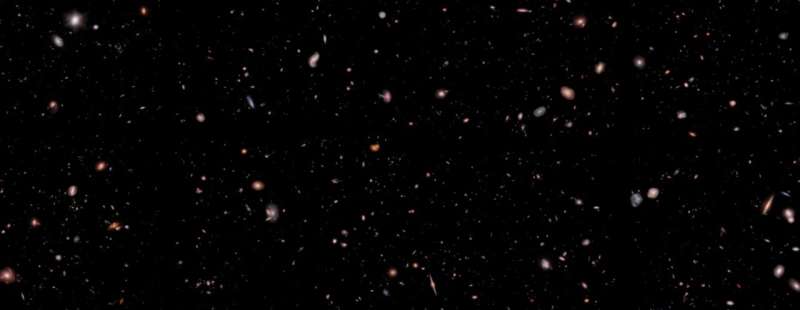This article has been reviewed according to Science X's editorial process and policies. Editors have highlighted the following attributes while ensuring the content's credibility:
fact-checked
trusted source
proofread
New 3D visualization highlights 5,000 galaxies revealed by Webb in CEERS survey

The Space Telescope Science Institute's Office of Public Outreach has released a new scientific visualization of data from the CEERS (Cosmic Evolution Early Release Science) Survey. The video represents Webb's exploration of the region known as the Extended Groth Strip, revealing many galaxies that have never been seen before. It displays a wealth of galaxies across the universe and concludes on Maisie's Galaxy, which resides 13.4 billion light-years away from Earth.
This video, a scientific visualization of the galaxies captured as a part of the CEERS (Cosmic Evolution Early Release Science) Survey, showcases a large undertaking by NASA's James Webb Space Telescope. It flies by thousands of galaxies, starting with those nearby and ending with less-developed galaxies in the very distant universe, including one never seen before Webb.
The area highlighted in this visualization is a small part of the Extended Groth Strip, a region between the Ursa Major and Boötes constellations originally observed by the Hubble Space Telescope between 2004 and 2005. While this vast region contains about 100,000 galaxies, the visualization focuses on approximately 5,000—with the nearest and more complex galaxies, shown in the beginning, located within a few billion light-years of Earth. As the visualization proceeds, showing galaxies farther away from Earth, we see different stages of the universe's history and evolution.
The visualization's farthest galaxy, known as Maisie's Galaxy, is a target of great interest to astronomers. It formed about 390 million years after the big bang, or about 13.4 billion years ago. It's not only one of the first bright, extremely distant galaxies found by Webb, but it's also an example of an early galaxy that only Webb could see. This is because Webb's instruments can capture the light from these early galaxies, which has been shifted to infrared wavelengths by the expansion of the universe.
"This observatory just opens up this entire period of time for us to study," said Rebecca Larson of the Rochester Institute of Technology in Rochester, New York, one of the survey's investigators. "We couldn't study galaxies like Maisie's before because we couldn't see them. Now, not only are we able to find them in our images, we're able to find out what they're made of and if they differ from the galaxies that we see close by."
Steven Finkelstein of the University of Texas at Austin, principal investigator of the CEERS program, continued, "This observation exceeded our expectations. The sheer number of galaxies that we're finding in the early universe is at the upper end of all predictions." The observatory's ability to conduct surveys like these provides a demonstration of Webb's instruments for astronomers to reference for future observations.
This visualization not only shows just how far Webb can observe, but also how much it builds off the accomplishments of Hubble. In many cases, Hubble's observations, along with Webb's data from the CEERS Survey, enabled researchers to determine which galaxies were truly far away—the early-universe galaxies of interest—and which were nearby, but so dusty that their visible light was obscured.
With these observations, the next goal for researchers is to learn about the formation of stars in these early galaxies.
"We're used to thinking of galaxies as smoothly growing," Finkelstein remarked. "But maybe these stars are forming like firecrackers. Are these galaxies forming more stars than expected? Are the stars they're making more massive than we expect? These data have given us the information to ask these questions. Now, we need more data to get those answers."
Provided by NASA





















